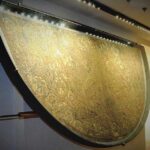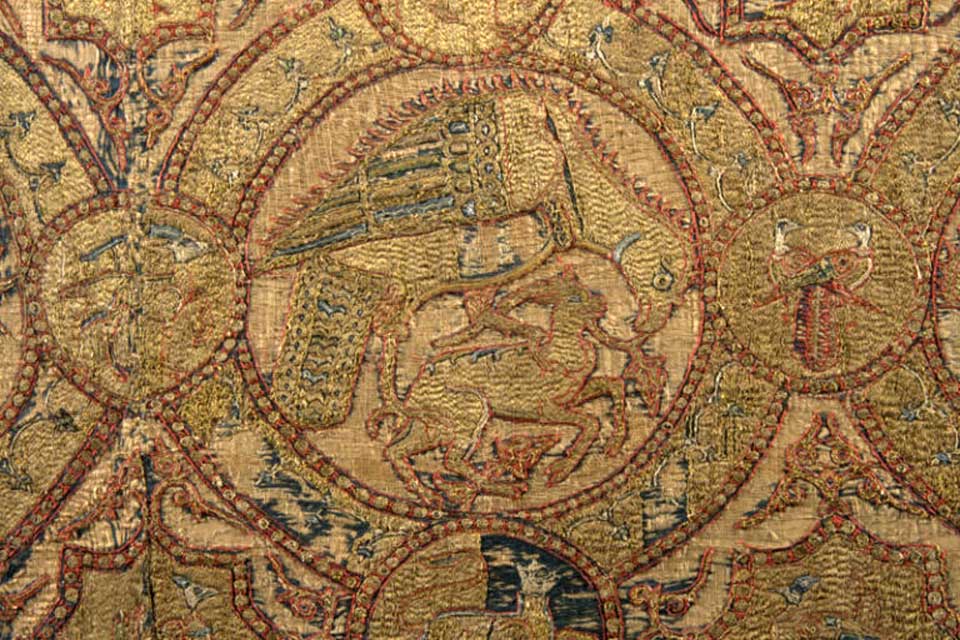The Cathedral in Fermo in Italy has preserved a unique chasuble, said to have belonged to Thomas Becket. A new book explores the golden textile in all its glorious details
The Chasuble of Thomas Becket
Ed. by Avinoam Shalem
Hirmer Verlag 2017
REVIEW
Presbyter was a clerk in the service of Cardinal William of Pavia, who as papal legate was charged with negotiating a reconciliation between the Archbishop, Thomas Becket, and the King, Henry II. From letters written by Thomas, we know he felt a fundamental distrust towards the legate and his man, Presbyter. Thus, nothing came out of the effort, except at least one meeting between Presbyter and the future Saint at Montmartre in 1169. Likely, there were other occasions.
It has been suggested that this Presbyter was identical to another cleric with the same name, who was bishop in Fermo from 1184 -1194 (1202). This Presbyter was early on active in the promulgation of the new cult. As Archdeacon at Fermo, he had already founded a new church to St. Mary Magdalene and St. Thomas Becket. We know of a grant from 1188 to the church. According to later legend, the church had functioned as a gateway at the harbour for returning crusaders infected by leprosy. Now a ruin, the church (or rather the charter) sheds some light on the fascinating golden chasuble preserved as a relic of the Saint at nearby Fermo.
A chasuble, casula, is a bell-shaped garment worn as a tent by a priest, who would stick his head through an opening in the middle. This chasuble was made of heavy dark-blue silk and covered with large and smaller roundels embroidered in gold and coloured silk, showing fighting and victorious animals and hunting scenes. In betwixt these medallions, we see – if not read – a number of Islamic inscriptions.
The present book edited by Avinoam Shalem should be read as a biography of the textile and provides a detailed study of the embroidery, the motifs, the inscriptions, and a comparison with other textiles featuring the same elements. “Applying the word “Biography”, I conceptualised this book as one that provides as many visual and literary sources on the chasuble in its medieval, late medieval, and early modern times and discussing its modern history as well”, Shalem writes in the introduction, holding twelve chapters and a rich collection of photos – both historic and new – documenting the precious object.
The different takes on the chasuble have been organised around three topics: a general introduction with history and background, a study of the textile in its materiality, and its wider context. Written by different textile historians and medievalists, this approach accounts for several tiresome repetitions. On the other hand, the book does offer a conscientious and detailed exploration well worth a read.
Following the arguments, it appears the textile was in all probability produced in Islamic Spain and likely in Cordoba. And likely as a tent used by a very high-ranking Muslim. The large and impressive roundels indicate the status of the person for whom the tent was made.
Exactly when, is debatable: the book’s contributors suggest different dates – ca. 1000, ca. 1030 or sometime between 1030 and 1120. This places the textile in a period characterised by political fragmentation and the proliferation of the independent Taifas.
Was the textile a gift or a piece of war-booty? We don’t know. Somehow, it entered the Christian world and, from there, the gift-economy, which was part of the High Middle Ages’ political landscape. Who gifted it to whom and at what point, we cannot know. Nor can we know at what point the tent was cut up into 39 fragments and remade into a chasuble. Was the precious textile a gift to Thomas while he was acting as chancellor for Henry II? And was the reworking of the textile orchestrated by Thomas Becket after his ordination as Archbishop? And if so: how did it enter the hands of Presbyter? Or was the reworking, a pious act carried out by Presbyter after his ordination as bishop? Did he feel exhilarated by dressing up like the Saint by wearing the chasuble?
We shall likely never know. Nevertheless, the essay by Ursula Nitgen provides a detailed and exciting gazetteer of how Becket’s textiles and bits and pieces thereof constituted a vast bulk of potential relics to be used as “gifts” bolstering the growing cult and the status of Canterbury. Not least in Rome, the acknowledgement of the new Saint was supported early on by some extraordinary gifts and relics, among others Becket’s shirt, preserved today at the Maria Santa Maggiore. Not least, his bloodied shirt and part of his brain came to be kept there since 1172. At this point, William of Pavia was no longer papal legate, but Presbyter may well have become part of other diplomatic missions. As part of these networks, gifts or relics – large or small – played a significant role. From Rome, the veneration of the new Saint spread to the whole of Italy.
This is a beautiful book. Lovely photos, an engaging text and a handful of interesting perspectives on the world of textiles in the 12th century. Not all essays are convincing, and some ideas are highly speculative. But well worth a read.
Karen Schousboe
VISIT:
 Muse Diocesano di Fermo
Muse Diocesano di Fermo
Piazzale Girfalco
Fermo

